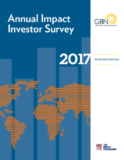The Global Impact Investing Network (GIIN) today published the seventh edition of its Annual Impact Investor Survey report, which presents continued progress in the dynamic impact investing industry, officially established only ten years ago. Capturing data from 209 of the world’s leading impact investors, this survey presents a detailed analysis of market activity, capital flows (including by geography and sector), and investor insights into key market topics. In 2016, survey respondents committed a total of USD 22.1 billion into nearly 8,000 impact investments. In total, respondents manage nearly USD 114 billion in impact investing assets, a figure which serves as a bestavailable ‘floor’ for the size of the impact investing market.
The report presents extensive information on many aspects of today’s impact investing market. Some key topics from this year’s survey report include:
- Satisfaction with financial and impact performance: The overwhelming majority of respondents reported that their investments have either met or exceeded their expectations for both impact (98%) and financial performance (91%).
- Entry of large-scale financial firms: There have been an increasing number of large, well-known asset managers and other financial firms entering the impact investing space. Respondents felt that this trend will help professionalize the market, bring in much-needed capital, and enhance the credibility of impact investing. But respondents also believe that this trend is associated with a risk of mission drift or ‘impact dilution.’ Half also felt that there is a risk of capital shifting away from smaller intermediaries.
- Progress on key indicators of market growth: Investors reported progress on a number of factors, including an increasing abundance of professionals with relevant skillsets (90% noted progress) and greater availability of market research and data on products and performance (89% reported progress).
- Commitment to the Sustainable Development Goals: About 26% of respondents track their impact investment performance to the United Nations Sustainable Development Goals (SDGs) and another 34% plan to do so in the near future. The SDGs have served as a rallying cry for many impact investors to link their investments to a broader international initiative.
- Continued commitment to impact measurement: Nearly universally, respondents measure the social and/or environmental performance of their impact investments, using a mix of proprietary metrics, qualitative information, IRIS-aligned metrics, and other tools and frameworks.
- Interest in key sectors and geographies: Top sectors to which respondents allocated capital were housing, energy, and microfinance. Top geographies of investment were the U.S. & Canada, Europe, sub-Saharan Africa, and Latin America & the Caribbean.
- Strong recognition of the role of below-market-rate capital: While two out of three respondents target risk-adjusted, market rates of return, there was broad agreement among respondents that below-market-rate capital plays a valuable role in impact investing. Roughly four out of five respondents agreed that this type of capital has several benefits, including its ability to mitigate risk of investments to attract new investors, act as a bridge between philanthropy and market-rate capital, and capitalize opportunities that may never lend themselves to risk-adjusted returns.
- Identification of challenges to industry development: Just over half of respondents reported that a lack of appropriate capital across the risk/return spectrum remains a significant challenge. Investors also reported that defining and segmenting the diverse industry remains an issue, as does the lack of suitable exit options.
The 2017 findings are based on survey responses from 209 impact investing organizations that include fund managers, banks, foundations, development finance institutions, pension funds, insurance companies, and family offices. The 2016 edition of the Annual Impact Investor Survey featured a sample size of 158 participants that committed more than USD 15 billion to impact investments in the previous calendar year (2015) and reported a total of USD 77 billion in impact assets under management.
“This year’s annual survey details an impact investing industry that is becoming increasingly established and professionalized, but also a market that is complex and diverse,” said Amit Bouri, GIIN Cofounder and CEO. “The findings allow us to dig deeper into the topics the industry will need to concentrate on to further develop the market and achieve the broad global impact we seek.”
The study was produced with support from the U.K. Government through the Department for International Development’s Impact Programme. This study was also supported by the John D. and Catherine T. MacArthur Foundation.



